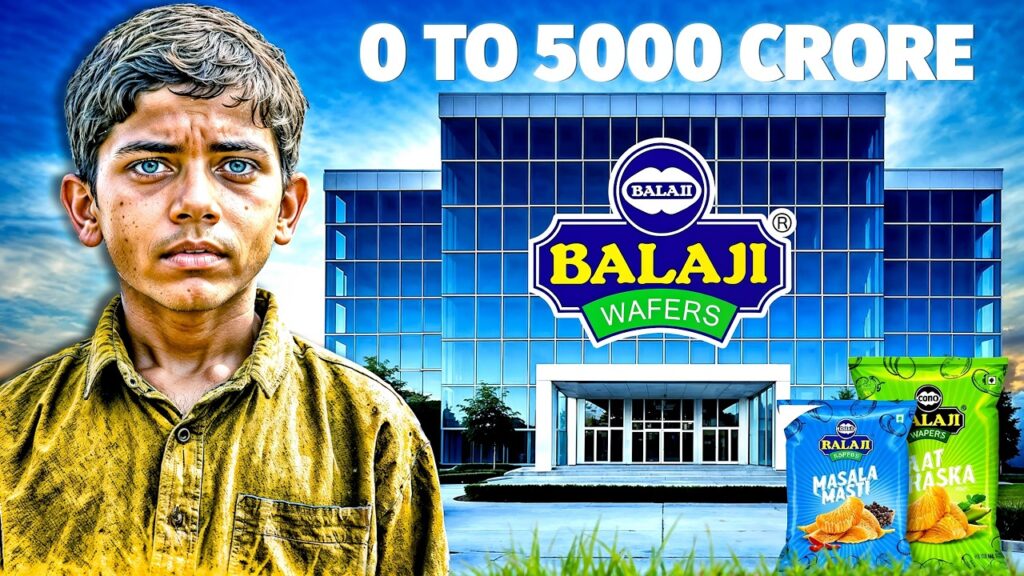Balaji Wafers: The Inspiring Journey of Chandubhai Virani

From humble beginnings to becoming a multi-billion dollar snack empire, the story of Balaji Wafers is one of resilience, innovation, and determination. Chandubhai Virani, a farmer’s son, turned challenges into opportunities, crafting a legacy that inspires countless entrepreneurs. This blog post delves into the incredible journey of Balaji Wafers, highlighting the strategies that led to its remarkable success.
The Early Days: A Struggle for Survival
Chandubhai Virani was born into a poor farming family in Gujarat. His father, Popat Ramji Bhai, struggled to make ends meet, particularly after a drought devastated their crops. In a desperate bid for a better future, he sold their ancestral land for ₹20,000, distributing the money among his three sons to start a business.
At just 15 years old, Chandubhai and his brothers moved to Rajkot, where they attempted to launch a business selling agricultural products. Unfortunately, they were scammed by a dealer who sold them fake fertilizers, leading to the collapse of their first venture. With no other options, they searched for jobs but struggled due to their limited education.
Eventually, Chandubhai found a job as a watchman at Astron Cinema, earning a meager ₹90 a month. He also worked in the theater’s canteen, selling sandwiches. His dedication paid off when he earned the trust of the theater owner, who allowed him to run the canteen. However, the perishable nature of the sandwiches posed a significant problem, leading Chandubhai to brainstorm for a more sustainable product.
The Birth of Balaji Wafers
In 1982, after moving his entire family to Rajkot, Chandubhai began selling potato wafers, initially purchased from a local vendor. However, he faced issues with supply inconsistencies and damaged products. Frustrated, he decided to take matters into his own hands and began making chips at home.
With a small investment of ₹10,000, he set up a makeshift production unit in his courtyard. The early days were challenging, as he struggled to perfect the frying process. But after continuous experimentation, he succeeded in creating high-quality potato wafers. This newfound success led to partnerships with local merchants and a growing demand for his product.
In 1984, the brand name “Balaji” was inspired by a nearby Hanuman temple. This marked the beginning of a journey that would see the company grow from a local favorite to a national powerhouse in the snack industry.
Scaling Up: Challenges and Innovations
By 1989, demand had skyrocketed, prompting Chandubhai to consider scaling up production. He sought a bank loan of ₹50 lakhs to establish Gujarat’s largest potato wafer plant. This was a risky move, considering the reluctance of investors to fund new ventures at the time.
Despite the challenges, Balaji Wafers quickly gained traction, competing against established brands like Uncle Chips and Simba. Their use of advanced technology set them apart, as many competitors were still producing chips by hand.
However, success brought its own challenges. In 2011, PepsiCo sued Balaji, claiming that their product design infringed on Lays’ trademark. The high court ruled in favor of PepsiCo, forcing Balaji to redesign their packaging. Despite this setback, Chandubhai remained confident, insisting that consumer loyalty was tied to the brand name rather than packaging.
Growth Strategy: The Path to Success
Balaji Wafers adopted several key strategies to ensure continued growth and market dominance. These strategies included:
1. Market Expansion
Balaji Wafers extended its reach beyond Gujarat, establishing manufacturing units in various states to cater to local tastes. This approach allowed them to customize their product offerings, ensuring they met consumer preferences across different regions.
2. Product Diversification
To stand out in a competitive market, Balaji introduced a range of products, including namkeen and western snacks. They continually innovated, adding healthier options like baked wafers and roasted snacks to their portfolio.
3. Investment in Technology
Chandubhai recognized the importance of automation early on. By investing in state-of-the-art machinery, Balaji improved production efficiency and maintained consistent quality, which was crucial for building a loyal customer base.
4. Customer-Centric Philosophy
Balaji Wafers prioritized customer satisfaction, ensuring they provided high-quality products at reasonable prices. This commitment helped them build a strong brand image and foster consumer loyalty.
Facing Adversity: The Power of Resilience
The journey of Balaji Wafers was not without its hurdles. After the lawsuit from PepsiCo, many believed the company would struggle to recover. However, Chandubhai’s unwavering belief in his brand’s value proved to be the key to overcoming adversity.
Instead of faltering, Balaji Wafers continued to grow at an impressive rate of 20-25% annually. By 2019, the company had expanded its product range to over 65 offerings and established a robust distribution network of more than 1,200 dealers.
Conclusion: A Legacy of Inspiration
The story of Balaji Wafers is a testament to the power of perseverance, innovation, and a customer-first approach. Chandubhai Virani’s journey from a struggling farmer’s son to the owner of a multi-billion dollar snack empire serves as an inspiration to aspiring entrepreneurs everywhere.
Balaji Wafers not only exemplifies how dedication and hard work can lead to success but also highlights the importance of adaptability in the face of challenges. As the company continues to grow and innovate, it remains a shining example of how local flavors and quality can triumph over global giants in the competitive snack industry.
